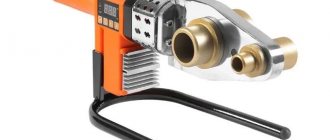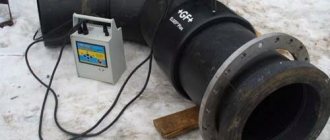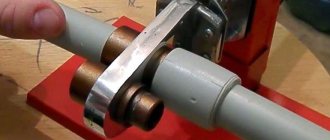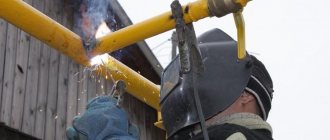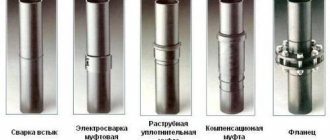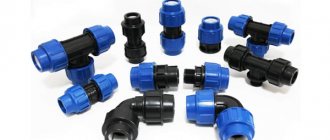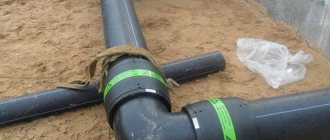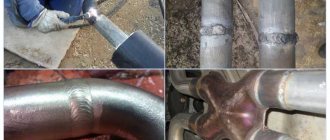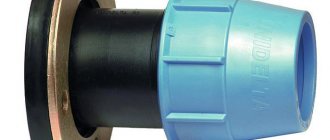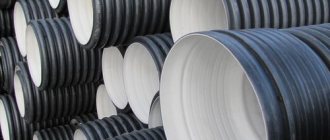Roman Feliksovich, Voronezh asks a question: Good day. I am contacting you for this reason. I want to find out how polyethylene pipe couplings are welded.
The fact is that I need to fix the water supply at my dacha with my own hands. The old pipes in the underground were made of metal, they were all rusty and needed to be replaced. That's why the accident happened.
Nowadays no one uses steel pipes. Everyone installs pipelines made of polypropylene products. The most profitable and simplest option for connecting polyethylene pipes is the joining method.
But again, this process requires a large welding machine that needs to be placed somewhere. And also, although the coupling connection is somewhat more expensive, the welding unit there has much smaller dimensions. Which suits me very well.
Besides, I don’t plan to use welding often. I'm waiting for an answer. The expert answers: The technology for welding polyethylene pipes with couplings involves the use of special devices: a welding machine and an electric coupling with embedded heating elements. The connection assumes a pressure of 16 atm.
and is feasible on products with a not too large diameter. The most popular is a simple coupling, used to connect straight sections of a pair of workpieces. Socket connection is a more expensive method than butt welding. Coupling welding is indispensable when it is not possible to place a large unit for butt welding. Welding procedure technology: Pre-prepared pipes and electrofusion couplings for connections are installed in clearly co-directional directions.
The products are prepared by removing all surface contaminants in the welding area. The device supplying the current is turned on. As a result, the embedded elements of the electric coupling begin to heat up, simultaneously melting the surrounding material. The area of the melting polyethylene in the unit increases, and it becomes possible to transfer the heat of the product to its surface, which passes into a fusible state. The diameter of the heated product increases. The molten polyethylene (enclosed in the circumference of the electrofusion) acquires the pressure necessary for welding. At this point, it is possible to turn off the power supply.
After a certain period of time, the electrofusion homogeneous connection will be completely ready. Recommendation from experts: a high-quality feeding apparatus is able to perform the entire welding procedure independently and enter the information into a special electronic protocol. Welding large-diameter products requires an additional heating procedure. What is important to consider when installing a pipeline with your own hands? The heating technique is carried out according to the following scheme: The coupling is combined alternately on each side with the workpieces. First of all, a full welding cycle is performed with one of the parts. Then the second half of the electrofusion coupling is welded with another workpiece. Each side of the electrofusion coupling of significant diameter is connected to the power supply separately. Electrofusion couplings with d 110 mm are affordable, which makes it possible to economically equate electrofusion welding to butt welding. Share a useful article: Similar articles:
The reliability and proper functioning of a plastic pipeline (especially if it is pressure) directly depends on the method of connecting the pipes of which it consists.
The most durable method is, of course, welding polyethylene pipes. With its help, you can connect pipeline elements not only with each other, but also with fittings. Its technology will be discussed in our article.
Welder performs installation
Connection methods
A high-quality welded connection of polyethylene pipes allows you to maintain the original flexibility of HDPE pipes and does not have a negative impact on their strength. Such a pipeline is a monolithic structure, as if it were one pipe of impressive length. Welding is used when installing communications in an open manner (on the surface of the ground with subsequent installation in trenches) and during trenchless renovation.
Many people do not know how to connect polyethylene pipes using welding equipment. There are two methods for welding pressure pipes made of polyethylene:
- butt; electrofusion.
Features of the method
In short, the installation of a plastic pipeline in this case begins with heating and gradual melting of the connected ends using the heater of the welding unit. This is followed by connecting the pipes with pressure applied.
Butt welding process diagram
Connecting pipes using butt welding is not as easy as it might seem to an amateur. Only qualified, experienced specialists using professional welding equipment can guarantee high quality welds. On the other hand, butt welding has such important advantages as those listed below:
- work is carried out without the involvement of heavy machines and equipment; a maximum of two people is required; low energy costs - installation of a HDPE pipeline is faster and easier compared to laying a metal (steel) analogue. This is especially true when laying long pipes (sold on reels or in coils), which can reduce the need for welds by 50-100 times. Not only the cost of human labor is reduced, but also the installation time and, accordingly, the cost of the issue.
To perform butt welding, it is necessary to prepare pipes and fittings with identical parameters:
- diameter; wall thickness; polymer grade.
Butt welding technology
The welding technology is described below:
- The ends of the pipes to be connected are leveled and cleaned of dirt and irregularities in order to achieve precise contact between the elements.
Pipe ends before connection
Afterwards, the heater continues to act on the ends of the pipes so that the heat gradually spreads inside each pipe and the melting of the polyethylene begins.
The temperature and exposure time are selected taking into account the properties of the material of the selected brand according to the welding table in order to preserve the physical and chemical characteristics. When a certain time is maintained, the welding machine is withdrawn. This must be done very carefully and quickly to prevent damage to the pipes and the settling of foreign particles and contaminants. After the heater is removed, the pipes are connected, molecular bonds are formed at the junction, and the final burr is created. Please note that the pressure applied should be the same as during the procedure for melting polyethylene.
Connecting pipes after heating
- The final point is cooling the weld, the polyethylene at the joint settles and gains the maximum possible strength. The result is a uniform, symmetrical pile. If the seam lacks symmetry, it means installation errors were made.
Electrofusion welding
Another known method of welding polyethylene pipes is installation using electric couplings (it is also called thermistor welding). The main positive characteristics of electrofusion welding are the high-quality connection of pipeline elements and a simple, quick installation process. With its help, unlike butt welding, you can connect pipes with a wall thickness of 4 mm or less.
Instructions for welding using electric couplings involve the following steps:
- Cleaning the ends from dust and dirt to length? coupling length or even more - is done mechanically. Degreasing of surfaces, removal of the oxide layer.
Set of equipment for electrofusion welding
- Installation of the coupling on the pipe, centering. Welding connection of the coupling and the end of the pipe, a welding machine for polyethylene pipes is used. Cooling of the joint occurs naturally, there should not be any outside influence on the seam.
Soldering of polyethylene pipes and fittings can be carried out by welding machines with different degrees of automation. Depending on the integrity of a particular manufacturer, the build quality of the equipment itself and its ability to work in different conditions may differ.
Electrofusion soldering process
A welding machine for sleeve welding is very easy to use, equipped with a scanner that reads information from a bar code located on the fitting (welding time, voltage, temperature, etc.). Based on the data received, the unit itself sets the welding parameters, automatically performs the task, controls all stages and, in case of an error, notifies the operator by displaying its digital designation on the screen.
HDPE pipes (made from low-density polyethylene) are a popular building material that is actively used these days. This type of pipe is ideal for installation of pressure and non-pressure pipelines. The small mass of the material, ease of processing and operation, have made them indispensable in modern realities.
Pipeline installation has turned into a pleasant and interesting hobby - many home craftsmen do the work themselves. There are several ways to connect pipes, among which the most popular is welding polyethylene pipes.
In general, polyethylene pipes are a high-tech, elastic and durable material. The material withstands environmental influences well. That is why many experts recommend using the material for the construction of pipeline systems of any type.
The popularity of HDPE pipes is justified by the fact that anyone can install a pipeline system, even a beginner in this matter. In this article we will look at the main types of connections and study the most reliable of them.
Advantages and disadvantages of electric welded fittings for HDPE pipes
The advantages of these products include the following characteristics:
- The use of electric welded couplings ensures ease of installation of the pipeline structure.
- Long service life - about 50 years.
- The affordable price allows these products to be used by a wide range of consumers.
- Ease of installation. You can work with electric welded couplings for polyethylene pipes in limited space, as well as in hard-to-reach places.
- Versatility. These elements can be used to connect HDPE pipes with any parameters.
- Quick assembly of the structure.
Any type of pipeline made using such connections is characterized by high operational reliability.
Although electric-welded couplings have significantly fewer disadvantages, they should nevertheless be taken into account when installing the system:
- the compound does not tolerate exposure to alkaline and strongly acidic environments;
- Electric welded fittings cannot be used when installing hot water supply and heating pipelines. As mentioned above, such connections are designed for temperatures up to 40˚C;
- high price. This drawback is not so critical if you take into account the price of welding equipment used to install fittings of other designs, the need to attract a highly qualified specialist and subsequent payment for his work.
In addition to the usual repairs and connection of communications, electric welded couplings are ideal for connecting pipes not only with different diameters, but also made of different materials. The most common transition is from a metal pipeline segment to a polyethylene one.
Using electric couplings, both pipes of the same type and those from different materials are connected.
Types of polyethylene pipe connections
In modern construction, a couple of types of HDPE pipe connections are known:
- Detachable type (using sockets or flanges); One-piece type (welding HDPE pipes).
The choice in favor of one or another connection method is determined by the conditions of use of the pipeline (for what purpose). If a pipeline with a high-pressure liquid supply is involved, the butt welding or electrofusion welding method is used.
This technique has proven itself to be the most reliable. In pipelines where liquid flows independently (without pressure), detachable type connections are widely used, which are much easier to install and can be installed without special equipment.
Welding process
The device for electrofusion welding of HDPE pipes is a universal type of equipment. The reliability of the resulting product is ensured by the tight connection of the parts. Before starting work, it is necessary to carry out preparatory work, which consists of cleaning the ends of the pipes to be connected and ensuring their evenness. A coupling should be placed on the ends of the cleaned and degreased pipes and this unit should be fixed in the positioner. One of the main advantages of such devices is the absence of the need for preheating.
The machine for welding HDPE electric welded couplings must be connected to the electrical network. The cables should be connected to the coupling heating element. Then it’s time to select the required welding mode. Once the time and temperature are set, the machine can be started to carry out the welding process. Control is carried out by the type of seam produced and by indicators.
After the process is completed, it is necessary to disconnect the cables from the network. You should wait some time for the resulting assembly to cool down. This is necessary to stabilize the resulting compound.
Butt welding modes for HDPE pipes - studying the features
To perform welding work on HDPE pipes, in modern construction there are several methods that have their own advantages and disadvantages. Among them the following are known:
- Butt welding; Coupling (using sockets) welding; Electrofusion type of welding work.
We recommend! How to cook aluminum semi-automatically in argon
So that a simple and inexperienced master does not have questions, we will consider each of them separately and study the principle of operation.
We weld polyethylene pipes end-to-end - features of the work
Butt welding of large-diameter plastic pipes is one of the simplest and most inexpensive options for creating a HDPE pipeline. The basis of this technique is as follows - initially, the ends of two pipes are heated, and then, under a certain level of pressure, they are joined to each other, forming a reliable and monolithic connection. This method is widely used by specialists for connecting pipes whose walls are thicker than 0.5 cm and whose diameter exceeds 5 cm.
Attention! Under no circumstances should you weld polymers that are not identical in composition. It is necessary that all elements were purchased at the same time, in one batch.
Do-it-yourself butt welding is carried out according to the following algorithm:
- Initially, the clamps are mounted, centered and fastened to the pipe; The joint is trimmed mechanically; The axis is checked; Using a welding mirror, the ends of the elements being connected are heated; The welding mirror is removed, the HDPE material is joined under a certain level of pressure; After completion of the work, the material is left to cool and move on to the next junction.
In total, for this type of work, there are three types of equipment:
The simplest of them are manual units.
They are used for joining (welding) pipes with a small diameter. All equipment settings are made by the operator, who uses the table for welding polyethylene pipes and sets the necessary parameters using it. After heating, the ends will have to be connected manually. Semi-automatic thermistor welders used for joining HDPE pipelines differ from manual ones in the presence of hydraulics, which includes a hydraulic station and a centralizer.
The main advantage of the unit is that heating and welding are carried out automatically. Welding modes must be set by the operator. Automation is an excellent welding system that exclusively requires human presence. The operator only needs to set a few parameters - material grade, SDR and pipeline diameter.
Otherwise, the machine will do the job. This method is attractive because it completely eliminates the human factor - all joints are smooth and reliable. The only drawback is the high cost of the products.
Parameters for butt welding of HDPE pipes It is necessary to take into account the fact that the technical map does not imply such data as the heating temperature of the joints. It is necessary to remember that PE 100 grade material heats up and melts at a temperature of 220°C, PE 80 grade material – from 200 to 220°C.
Simplicity and cost-effectiveness of welding machines
The ease of use of this method allows it to be carried out automatically, without any control or intervention in the process itself. The devices used for welding are economical and characterized by low power consumption.
All this allows us to classify such technology as electrofusion welding of HDPE as the most popular in today’s market. Another undoubted advantage is the ability to use it to eliminate damage during emergency and restoration work.
Sleeve welding is another inexpensive option.
Welding with couplings is an ideal option for connecting pipelines whose diameter does not exceed 63 mm. For this operation, you can use a simple soldering iron (welding machine). If it is necessary to weld large diameter pipes, an industrial mechanical apparatus is used.
Attention! Before starting welding work, stock up on fittings (it is advisable to buy more, just in case).
For the work, a specialist will need a tool such as a tape measure and a pipe cutter. The socket welding process involves the following steps:
- Initially, the welding machine is secured to the pipe using a special wrench. The temperature parameter is set - for HDPE pipes it is about 210-230°C; Pre-prepared fittings are placed on the nozzle and the plastic is completely heated (6-8 seconds is enough); The next stage is the heated fitting is placed on the ends of the pipes. It is necessary to hold the elements for about 10-15 seconds so that the plastic cools down;
The end result is a high-quality, tight connection. Heat-treated polymers are fused together.
Note! Do not overheat the elements. If it heats up too much, the fitting or pipe will simply curl up like a caterpillar and it will not be possible to make a high-quality joint.
The essence of the process
The meaning of the welding process is the dead fixation of the electrofusion coupling at the end of the pipe. To do this, combine the HDPE and the end of the coupling itself. Next, the end of the other pipe is brought in from the opposite side of the coupling.
One universal welding device will help you work with different HDPE.
Modern devices for EMC allow you to perform work automatically and take into account shortcomings, resulting in a durable and strong seam. The latter is practically not susceptible to high temperatures.
Electrofusion welding - basics
This type of work is classified as high-tech. The use of electric couplings allows you to create pipeline systems that can withstand the highest pressure, no more than 18 atmospheres.
Despite the high quality of the connections, this option is expensive compared to others. The problem is that to perform this type of operation, you will need to purchase overhead electric couplings, which are not cheap.
Electrofusion welding consists of the following set of actions:
- Before starting work, all elements and joints undergo a thorough cleaning procedure; The next stage is to put a fitting on the joint, which is a coupling with an embedded heater. Its task is to heat the plastic to a certain temperature; After all stages have been completed, voltage is applied to the coupling. The ends of the pipes begin to heat up and melt together with the coupling, and the result is a high-quality smooth connection that looks like a solid pipe.
Attention! After heating, you should not immediately remove the equipment - the joint must cool naturally in order to obtain a high-quality and reliable pipeline.
This technique is widely used in situations where it is necessary to make additional branches from the main trunk and make several connections in one session.
general information
The essence of this cooking method is the presence of a special heating element, namely an electric coupling. It is placed at the junction of the HDPE, heated almost until the latter melts and joins.
The design of the electric coupling includes an electric spiral. The passing current heats the spiral, which in turn heats the plastic of the coupling and the HDPE pipes placed underneath it.
At this point, the HDPE and the coupling merge. At the end, give it time to cool completely and the seam will have high strength.
Quality control - we check the result of the work
This procedure is carried out after completion of all work and is intended to identify the presence of possible defects that could arise during the installation of the pipeline. It should be noted that such a concept as a defect includes inhomogeneities of micro and macro types. These “troubles” can arise as a result of violations of welding and assembly technology.
Defects are divided into two types:
Also, it is necessary to note such types of defects as destructive and non-destructive - they arise in the process of exposure of the welded joint to polyethylene.
The quality check itself is carried out by laboratories, express methods, and special organizations that have a certificate from an industry testing center (conduct in-depth research). If the pipeline was laid by a master at home, then it is enough to check the seams for leaks - a test run of water is carried out and the system is monitored for 2-3 days.
Results
As it became clear, each method of welding HDPE pipes is good in its own way and applicable in certain conditions. Attention should be paid to the fact that working on any of the above-mentioned units does not require special training - it is enough to follow the technology and carry out the work in strict accordance with the requirements and tables.
Polyethylene pipes for water supply systems are increasingly being used due to the properties of the material.
The main characteristics of polyethylene are plasticity, strength, resistance to aggressive environments (for tubes made of low-pressure polyethylene HDPE) and inertness to temperature changes. That is why pressure polyethylene elements are suitable for installing the external part of a water supply system or gas pipeline of a private house. And to connect the main line into a single whole, welding of polyethylene pipes is used.
How to connect pipe elements made of PE (polyethylene) with your own hands is discussed in the material below.
Types of PE pipe connections
Polyethylene pipes can be connected into a single pipeline using different methods
Polyethylene pipes can be connected into a single pipeline using different methods. Moreover, each of them is suitable for specific conditions.
Thus, joining HDPE tubes using fittings and couplings (socket welding) is used mainly for installing the internal part of the water supply system in the house. Do-it-yourself pipeline installation using butt welding.
This method is used for installing an extended section of outdoor communications. In this case, pipes can be laid both on the surface of the soil and in a trench, followed by covering them with soil. Electrofusion welding. This method of connecting HDPE tubes is done using special plastic couplings with spiral elements built into them, which heat up as a result of the supply of current to it.
Let's take a closer look at each of the methods.
List of required equipment
You can get a strong seam through proper preparation for welding.
Take the following inventory:
- Electrofusion welding device
- Crimping Tools
- Disc pipe cutter
- Scraper
- Ruler
- White spirit, alcohol, acetone
- White marker
Recommendations for proper welding of PE pipes
Polyethylene pipes can be welded using special equipment called a soldering iron
Polyethylene pipes can be welded using special equipment called a soldering iron. At the same time, there are a number of certain rules that will make the connection of elements smooth, high-quality and airtight.
The requirements look like this:
- Before carrying out work, it is worth studying the HDPE characteristics for each pipe and verifying their compliance from certificates. Otherwise, the tubes simply do not fit together into a single sealed structure. The internal lumen of the tubes (diameter) must be identical for each cut intended for installation of communications. Before welding with your own hands, the ends of PE pipes must be cleaned of dust and dirt, and also degreased. Procedure welding should be performed only in a dry, heated room, in which drafts and high humidity are excluded. After joining two PE elements, any movement of the line should be avoided until the pipeline has completely cooled in order to prevent disruption of the communication clearance. In addition, it is worth covering the welding seam from direct contact sun rays.
Important: the ends of the tubes, on the opposite side from those being welded, should be securely closed to prevent cold air from entering the lumen. Low temperatures can disrupt the welding technology of HDPE pipes.
Socket welding (socket)
Connecting pipes using couplings and fittings is shown for HDPE pipes with a diameter of up to 63 mm
Connecting pipes using couplings and fittings is shown for HDPE pipes with a diameter of up to 63 mm. For these purposes, use a hand-held household soldering iron (welding machine). PE tubes of larger diameter are welded using an industrial mechanical apparatus.
Important: before performing socket welding, you must stock up on the required number of fittings plus a small reserve in case of defects in the work.
To carry out socket welding, in addition to a soldering iron, you need to prepare a pipe cutter and a tape measure.
The work of welding HDPE tubes is carried out in this way:
The welding machine is installed on the platform and securely secured. Nozzles of the required diameter are attached to the heating surface using a special wrench.
The welding machine is set to the desired temperature. For pipes made of PE (polyethylene), it should be 220-230 degrees. The parts prepared for welding are put on nozzles and held until the plastic is thoroughly heated. As a rule, this is 5-7 seconds. After the parts have warmed up, it is necessary to slowly, but all the way, connect the two elements and hold them in this state for at least 10 seconds so that the fitting and pipe do not change their welded position. After such manipulations, the internal the lumen of the pipe remains smooth and sealed, and the polymer processed by the welding machine forms a single whole.
Important: Excessive overheating of the pipes should be avoided. Otherwise, when connecting two elements, the plastic will simply fold into an accordion, which will disrupt both the internal lumen of the pipes and the quality of the connection.
Tip: after each welding procedure, be sure to clean off the melted polymer from the Teflon surface of the nozzles. Otherwise it will interfere with the next welding process.
Moreover, you need to remove the plastic exclusively with a wooden spatula. This way you can keep the Teflon intact and unharmed. It is prohibited to remove cold plastic or metal objects.
Extruder welding
It is a little more difficult to work with a hand-held hair dryer or soldering iron, since you need to additionally control not only the heating time, but also your own movements. If welding is performed incorrectly, the integrity of the HDPE pipes can be damaged or the seam can be damaged.
Photo - professional inverter
Step-by-step instructions for welding using an inverter:
- It is necessary to cut the communication to a certain size, be sure to clean the end;
- The temperature for HDPE welding is 260 degrees, the soldering iron is set at this level, and the welding nozzles are installed and warmed up at the same time;
- Before starting work, be sure to measure and mark the required installation depth; it should be at least 2 mm; Photo - fitting installation
- The most difficult part of this process is when you need to center the fitting and pipe in the nozzle. A professional machine contains a special centering mechanism; if it is not there, then just try to do everything very accurately;
- After the connection, they are pushed to the mark (not to the joint) and held for a certain time;
- At the end of the work, the device is turned off, and the place where the pipes are welded is fixed for cooling.
It is very important not to overextend the fastening; if the welding is tightened too much, the HDPE will become very thin or an influx of polyethylene will occur on the inner diameter. To control this moment, a special table is used:
| Outer diameter, mm | Weld seam, mm | Heating, sec | Connection, sec | Cooling, sec |
| 20 | 14 | 6 | 4 | 2 |
| 25 | 16 | 7 | 4 | 2 |
| 32 | 18 | 8 | 6 | 4 |
| 40 | 20 | 12 | 6 | 4 |
| 50 | 23 | 18 | 6 | 4 |
| 63 | 26 | 24 | 8 | 6 |
| 75 | 28 | 30 | 10 | 8 |
| 90 | 30 | 40 | 11 | 8 |
| 110 | 32 | 50 | 12 | 8 |
Video: Electrofusion welding of HDPE pipes
Butt welding
Butt welding is performed using special equipment with a mechanical or hydraulic drive
You can also butt weld HDPE pipes with your own hands. Butt welding is performed using special equipment with a mechanical or hydraulic drive.
Such a welding machine will allow you to join two elements of the tubes until they are completely and tightly connected. The most popular devices are those that have software control. Such equipment is characterized by full automation and the ability to control the welding process without operator intervention in terms of physical effort.
Before doing the work yourself, you should select HDPE pipes with uniform technical characteristics. It is advisable to weld tubes even from the same batch. Since here the polymer is joined at the molecular level, this approach will make the weld more airtight and reliable.
Important: tubes with a wall thickness of at least 5 mm and a diameter exceeding 50 mm are suitable for butt welding.
The principle of butt welding is to heat the ends of the pipe on a special plate. After melting, the PE plate between the ends of the two pipes being welded is removed and the elements are mechanically compressed until the polymer is completely mixed and soldered. After which the pipes must be allowed to cool completely.
Important: when marking tubes and cutting them, it is worth taking into account the technical reduction in the length of the pipe after welding. In order to correctly calculate the length reduction factor, you can use the data below:
- So, for pipes with a cross-section of 20 mm, the melting length (welding depth) will be 14.5 mm; Elements of 25 mm - 16 mm; For tubes with a diameter of 32 mm - 18 mm; For tubes with a cross-section of 40 mm - 20 mm; Pipes with a diameter of 50 mm - 23 mm.
Electrofusion welding
This welding method is applicable for connecting tubes with different wall thicknesses, different diameters, or for installing sewerage systems
Welding of polyethylene pipes using the electrofusion method is used if the pipeline is installed in a confined space where the technician is not able to move freely. In addition, this welding method is applicable for connecting tubes with different wall thicknesses, different diameters, or for installing sewerage systems.
Electrofusion welding of polyethylene pipes is considered the most expensive, but the joints obtained in this way are suitable for operation at a pressure of 16 atm. The work of joining tubes using this method is carried out using special couplings, the design of which has a heating spiral element.
Welding is performed as follows:
First of all, prepare all the necessary pipe sections with their obligatory degreasing and cleaning of dirt and dust. The inside of the electric coupling is treated in the same way.
For these purposes, it is advisable to use special wipes impregnated with an alcohol volatile substance. The ends of the welded pipes should be freed from production oxide by mechanical cleaning. In this case, the same ends should be cut evenly so that the connection is as tight as possible and prevents plastic from leaking inside the tubes. The pipes are placed in the positioner and an electric coupling is put on the joint. The ends of the pipes on the opposite side of the main should be closed at the time of welding with your own hands to avoid heat loss. An electric current is supplied to the terminals of the put-on electric coupling and the process is completed until the PE pipe melts and its connection is high-quality.
Important: the HDPE pipe welded in this way must remain motionless until it cools completely. Otherwise, there is a risk of breaking the geometry of the weld.
Installation options
Technologically, it is possible to connect HDPE pipes without welding or using a special welding machine. Both methods have their advantages and disadvantages; let’s look at the advantages of each fastening method.
Cold welding or pressing is the simplest option; it is a very cheap and accessible method, which is performed through the use of special couplings. This technology is used mainly for large diameter pipelines - from 20 to 300 mm. Compression fittings for cold welding have the following advantages :
- Ease of use;
- Large selection of sizes;
- Ensuring a tight connection with high sealing performance.
But pressing is mainly used only for fastening non-pressure water connections. Plastic pipes have relatively low rigidity, due to which, under strong internal pressure, the seam can simply separate, unlike welding fasteners, which are considered “dead.”
Classic welding, or as they say, soldering of HDPE pipes can be performed using the electrofusion method, or a specific welding apparatus is used to carry it out. Electrofusion couplings are a very practical method of connecting metal gas pipes, as well as plastic water supply communications. A coupling of a certain diameter is installed on the free section of the outlet, after which the second section of pipe is pushed into it. This kind of soldering is also called butt soldering, due to the fact that in order to achieve the most durable and tight fastening, it is necessary to install parts of the pipeline very tightly with a minimum gap.
Photo - fittings
It is convenient to work with couplings on large diameters, but this is not the best solution for washbasin outlets or heating communications. But flanged HDPE connections, if necessary, can be removed and urgent repairs can be made.
Photo - butt
Manual soldering of pipes is carried out using a soldering iron; it requires special equipment for organizing HDPE connections. To carry out such work, the temperature of the heating elements and the holding time are very important. Please note that these parameters are selected based on the technical characteristics of the soldering device, the thickness of the HDPE and the diameter of the taps.
Advantages of the technique:
- This is the most durable and reliable option. Due to the implementation of permanent fastening, it can be used both for pressure HDB and for non-pressure connections of shut-off valves;
- Flange connections can be used both when attaching an external system and when installing internal main pipes;
- No prior training required. It is enough to watch the video and read the SNiP standards, which detail how to trim, install and fasten.
But the disadvantages are that the connection cannot be removed if necessary. Despite all the advantages of this, sometimes it is necessary to open and clean the pipe.

